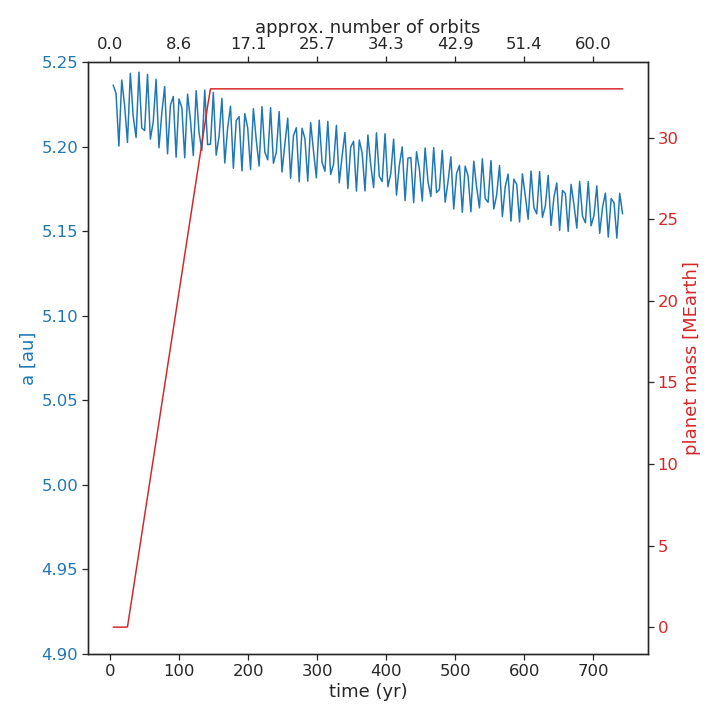Migration in gravitationally unstable protoplanetary discs
JAXA Supercomputer System Annual Report April 2019-March 2020
Report Number: R19ECWU00
Subject Category: Cooperative Graduate School System
- Responsible Representative: Elizabeth Tasker, Associate Professor in the Division of Solar System Science at ISAS / JAXA.
- Contact Information: Elizabeth Tasker(elizabeth.tasker@jaxa.jp)
- Members: Elizabeth Tasker, Ngan Kim Nguyen
Abstract
A long standing problem in planet formation theory is how the orbits of young planets change due to the drag of the gas still surrounding young stars. This project explores how gravitatonal structures (e.g. spiral arms) in the gas disc can affect this migration process. By modelling the motion of a planet in a gas disc around a star, we hope to demonstrate that the orbit of the planet depends on structures in the gas, thereby suggesting that different discs can result in different planet periods.
Reference URL
N/A
Reasons and benefits of using JAXA Supercomputer System
The tools needed for this project are three-dimensional hydrodynamical simulations, run on several hundred cores. This is beyond what is possible on a desktop computer. The code used (ChaNGa) is designed for supercomputer facilities parallised with MPI,. Many different simulations are needed to see how different disc structures (depending on factors such as cooling and mass) affect the migration of a planet.
Achievements of the Year
Established theoretical calculations of planet migration dictate the rate at which a low-mass planet will move through the planet-forming disc (protoplanetary disc). To prove that disc structure could affect the migration, we had to first prove that our planet moves as expected in a light disc without strong structurual features. Challenges included: (a) Choosing the right range of planet masses. The effect of the planet on the gas is smaller for a low-mass planet, making it difficult to correctly resolve the physics. However, a large planet would cause a gap to form in the gas and move to a different migration regime. (b) Adding the planet’s mass to the disc had to be done gradually to prevent a sudden interaction. (c) Realistic cooling had to be included. The result for a 33 Earth mass planet is shown in Figures 1 and 2. The average torque (figure 2) on the planet shows that this has settled to a steady rate in good agreement with the theoretical prediction. The planet’s orbit is slightly elliptiical (figure 1), but this is beng dampled by the gas. We then placed the planet in a heavier disc. The migration of the planet increased due to the strongly pull from the more massive disc and the rate began to vary due to the disc structure developing (figure 3).

Fig.1: The migration rate of a 33 Earth mass planet in the protoplanetary disc. Left side axis shows the planet’s distance from the star. The planet’s orbit is elliptiical, but becomes more circular due to damping from the gas.

Fig.2: The torque on the planet from the protoplanetary disc. The blue line shows the instantaneous torque on the planet at each output. The average torque is shown by the orange line. It rapidly settes to a value similar to the theoretical prediction (red line).

Fig.3: The migration rate of a 33 Earth mass planet in a heavy protoplanetary disc (10 x mass as in Figure 1). The migration rate is more rapid due to the larger gas mass and less steady as the disc becomes assymmetric.
Publications
– Poster Presentations
“Planetary Atrmospheres and Habitability”, 14 – 18 October, 2019, Okinawa. http://www.resceu.s.u-tokyo.ac.jp/symposium/resceu_sympo2019/
Usage of JSS2
Computational Information
- Process Parallelization Methods: MPI
- Thread Parallelization Methods: OpenMP
- Number of Processes: 144 – 264
- Elapsed Time per Case: 50 Hour(s)
Resources Used
Fraction of Usage in Total Resources*1(%): 0.25
Details
Please refer to System Configuration of JSS2 for the system configuration and major specifications of JSS2.
| System Name | Amount of Core Time(core x hours) | Fraction of Usage*2(%) |
|---|---|---|
| SORA-MA | 0.00 | 0.00 |
| SORA-PP | 683,254.12 | 4.43 |
| SORA-LM | 0.00 | 0.00 |
| SORA-TPP | 0.00 | 0.00 |
| File System Name | Storage Assigned(GiB) | Fraction of Usage*2(%) |
|---|---|---|
| /home | 7.95 | 0.01 |
| /data | 79.47 | 0.00 |
| /ltmp | 1,627.60 | 0.14 |
| Archiver Name | Storage Used(TiB) | Fraction of Usage*2(%) |
|---|---|---|
| J-SPACE | 0.00 | 0.00 |
*1: Fraction of Usage in Total Resources: Weighted average of three resource types (Computing, File System, and Archiver).
*2: Fraction of Usage:Percentage of usage relative to each resource used in one year.
JAXA Supercomputer System Annual Report April 2019-March 2020


